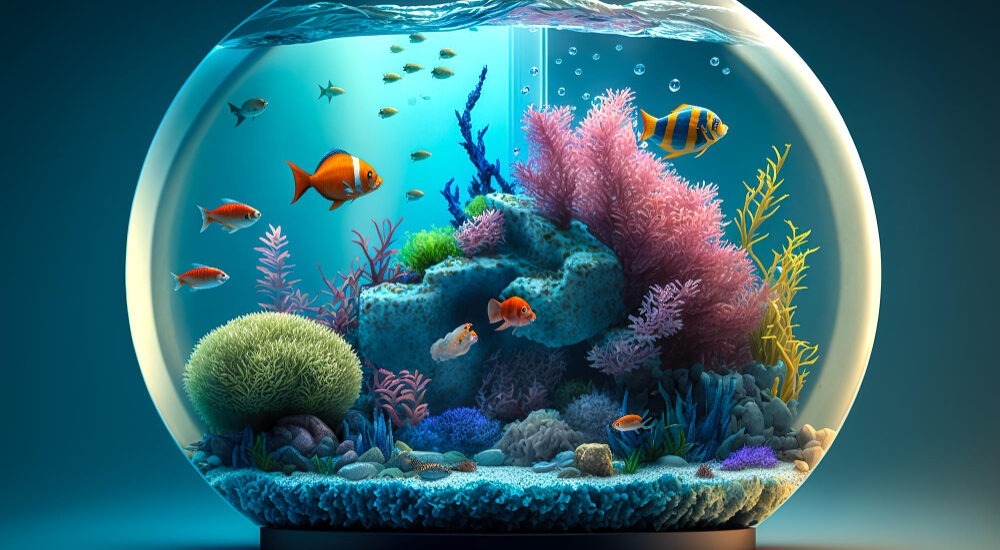Moving homes can be a daunting task, especially when you have delicate and living creatures like fish to consider. Aquariums, with their intricate setups and fragile ecosystems, present unique challenges during relocation. How do you ensure the safety and well-being of your aquatic pets during the transition?
How do you transport a heavy and fragile glass tank without causing damage? If these questions are swimming in your mind, you’ve come to the right place. In this comprehensive guide, we’ll dive deep into the steps and precautions you need to take when moving with fish and aquariums.
With expert insights from Stride Movers, your trusted moving partner, you’ll be equipped with the knowledge to make your move as smooth as possible for both you and your friends.
Understanding the Challenges of Moving Aquariums
Moving an aquarium is not just about transporting a glass box filled with water. It’s about ensuring the safety and well-being of a delicate aquatic ecosystem that thrives within it.
From the tiniest neon tetra to the most majestic angelfish, every inhabitant of your tank relies on a stable environment to survive and flourish. Moreover, the physical aspects of moving a tank, especially larger setups, can be daunting. Let’s delve into the intricate challenges one might face:
- Sensitive Ecosystem: Even minor changes in water temperature, pH, or salinity can stress or even harm your fish. Maintaining stability is crucial.
- Beneficial Bacteria: The water in your tank isn’t just H2O. It’s teeming with beneficial bacteria that help break down waste. Preserving this water is essential for the health of your fish.
- Fragile Equipment: Filters, heaters, and lights are not only essential for the functioning of an aquarium but are also delicate and can easily break if not handled with care.
- Weight Concerns: Even a small aquarium can be surprisingly heavy when filled with water, gravel, and decorations. Larger tanks can weigh several hundred pounds.
- Glass Vulnerability: The glass or acrylic that most tanks are made of can crack or scratch easily, especially during transit.
- Fish Stress: Moving can be stressful for fish. Rapid changes in their environment can lead to weakened immune systems or even shock.
- Setup Complexity: Aquariums often have intricate setups with plants, decorations, and specific substrate layers. Dismantling and reassembling them in the same order is a meticulous task.
Understanding these challenges is the first step to ensuring a successful move. With careful planning and the right precautions, you can mitigate risks and ensure your aquatic pets transition smoothly to their new home.
Preparation is Key
When it comes to moving with fish and aquariums, preparation isn’t just beneficial—it’s essential. Each fish species has its unique needs, behaviors, and sensitivities. Ensuring their safety and well-being during a move requires a deep understanding of these nuances.
From understanding their specific requirements to acclimating them to temporary environments, every step taken in preparation can make a significant difference in the outcome of the move. Let’s explore the pivotal preparatory steps:
- Species-Specific Needs: Different fish have different requirements. Researching your specific species can provide insights into their temperature preferences, stress factors, and dietary needs during the move.
- Health Check: Before the move, closely observe your fish for any signs of illness or stress. A healthy fish will handle the move better than a sick or weakened one.
- Temporary Housing: Invest in suitable containers or bags for temporary housing. Ensure they are spacious enough and can maintain stable water conditions.
- Water Preservation: Plan to preserve a significant portion of the tank’s original water. This helps maintain the beneficial bacteria and ensures a familiar environment for the fish.
- Fasting: Consider fasting your fish for 24-48 hours before the move. This reduces waste production, which can be harmful in a confined space.
- Acclimation Process: Gradually introduce your fish to the temporary containers, allowing them to acclimate to the new conditions. This can reduce shock during the transition.
- Backup Plans: Always have a backup plan. Whether it’s extra water on hand, battery-operated air pumps, or additional containers, being prepared for unforeseen circumstances can be a lifesaver.
By dedicating time to thorough preparation, you not only ensure the safety of your aquatic pets but also pave the way for a smoother and less stressful moving experience for both you and your fish.
Packing and Transporting the Aquarium
The intricacies involved in this phase can make or break the success of your move. From the water in the tank to the smallest piece of equipment, every element plays a crucial role in the well-being of your fish. Let’s delve deeper into the essential steps for packing and transporting your aquarium:
1. Draining the Tank and Preserving the Water
Begin by draining most of the tank’s water, but ensure you preserve a significant portion. This preserved water retains the beneficial bacteria essential for your fish’s health and helps in maintaining a familiar environment during the transition. Using clean containers or buckets with lids can prevent spillage during transport.
2. Safely Packing the Aquarium Equipment
Each piece of equipment, whether it’s the filter, heater, or lighting system, plays a pivotal role in the ecosystem. Carefully disassemble and pack each item in bubble wrap or soft cloth to prevent damage. Label each box or container to facilitate easy reassembly at the new location.
3. Tips for Transporting Live Plants
Live plants can be sensitive to changes in environment and handling. Place them in zip-lock bags with some tank water to keep them moist. If the move is long, consider using containers with a bit of tank water to keep them submerged. Ensure they’re protected from extreme temperatures.
4. Using Specialized Containers for Fish Transportation
While plastic bags filled with tank water are common for short moves, longer relocations might require specialized containers. These containers should be sturdy, adequately aerated, and spacious enough to prevent overcrowding. Remember to leave enough air space at the top.
5. Ensuring a Stable Temperature During the Move
Fish are highly sensitive to temperature fluctuations. If moving during colder months, wrap the fish containers in insulating materials or use heat packs. Conversely, during hotter periods, consider using cool packs and keeping them away from direct sunlight. Regularly monitor the temperature to ensure it remains stable.
6. Securing the Main Aquarium Structure
The physical tank, especially if made of glass, is susceptible to cracks and breaks. After draining, wrap the aquarium in moving blankets or bubble wrap, ensuring all sides, including the bottom, are protected. If possible, transport the tank in its original box or a well-fitted alternative.
7. Organizing and Labeling Everything
As you pack, label each box or container clearly. This not only helps during the unpacking process but also ensures that delicate items like filters or heaters aren’t accidentally mishandled. A well-organized move reduces the setup time at the new location, which is crucial for the well-being of your aquatic pets.
Setting Up the Aquarium at Your New Home
This process is not just about recreating the old environment; it’s an opportunity to optimize the living conditions for your aquatic pets. From choosing the perfect spot to reintroducing your fish, every step is pivotal. Let’s explore the essentials of setting up your aquarium in its new abode:
1. Choosing the Right Location
Opt for a location away from high-traffic areas to prevent vibrations or accidental bumps. Avoid direct sunlight, which can cause excessive algae growth and temperature fluctuations. Ensure easy access for feeding, cleaning, and maintenance.
2. Reassembling the Equipment
Start with the substrate, followed by decorations and equipment. Refer to the labels you made during packing to streamline this process. Ensure all equipment, especially heaters and filters, are functioning correctly.
3. Reintroducing the Preserved Water
Begin by adding the preserved tank water. This helps maintain the beneficial bacteria and offers a familiar environment for your fish.
4. Adding Fresh Water
When topping up the tank, ensure the new water is treated to remove chlorine and match the temperature of the preserved water. This ensures a stable environment for your fish.
5. Acclimating Your Fish
Before reintroducing your fish, let them acclimate to the new tank conditions. Place their transport containers in the tank water, allowing temperatures to equalize. Gradually introduce small amounts of the new tank water into their containers over a period of an hour.
6. Reintroducing Your Fish
Once acclimated, gently release your fish into the tank. Monitor them closely for any signs of stress or discomfort.
7. Monitoring Post Setup
For the first few days, keep a close eye on water parameters, equipment functionality, and fish behavior. Ensure the water remains clean and the equipment operates efficiently.
Read More: Best Moving Companies in Deerfield Beach
Post-move Care and Monitoring
After the meticulous process of moving and setting up your aquarium in its new location, the journey doesn’t end. The post-move phase is equally crucial, as it determines how well your aquatic pets adjust to their new environment. Close observation of your fish’s behavior is paramount.
Signs such as erratic swimming, loss of color, or unusual aggression can indicate stress or potential health issues. It’s essential to address these signs promptly, ensuring that the environment remains conducive to their well-being. Maintaining optimal water quality is a continuous responsibility. Regularly test the water for pH levels, ammonia, nitrites, and nitrates to ensure it remains within the ideal range for your fish species.
Any significant deviations should be addressed immediately, either through water changes or adjustments to the tank’s equipment. Additionally, after the move, it’s advisable to reintroduce regular feeding schedules gradually.
Ensuring the Safety and Well-Being of Your Aquatic Pets With Stride Movers
Stride Movers, with their expertise in handling delicate moves, can be the trusted partner you need during such transitions. Let’s delve into the reasons why and the benefits of entrusting your aquatic move to professionals like Stride Movers:
1. Expertise in Handling
Stride Movers have experience in moving various items, including delicate ones like aquariums. Their trained professionals understand the intricacies involved and can handle your tank with the utmost care, ensuring no harm comes to its inhabitants.
2. Specialized Equipment
From packing materials to transportation vehicles, Stride Movers come equipped with tools and equipment specifically designed to handle sensitive items. This ensures that your aquarium and its equipment are transported securely and safely.
3. Time Efficiency
With their systematic approach and expertise, Stride Movers can expedite the moving process, ensuring that your fish are not left in temporary containers for longer than necessary, reducing stress and potential health risks.
4. Reduced Risk of Damage
The risk of damage, be it to the tank or its equipment, is significantly reduced when professionals handle the move. Stride Movers take precautions to ensure that everything from the glass of the tank to the delicate filters is transported without any mishaps.
5. Advice and Guidance
Beyond just the physical move, the team at Stride Movers can provide valuable advice on preparing your fish for the move, setting up the tank at the new location, and post-move care, ensuring a smooth transition for your aquatic pets.
6. Insurance and Assurance
Professional movers like Stride Movers offer insurance options, providing peace of mind. In the unlikely event of any damage or mishaps, you have the assurance of compensation, ensuring the safety of your investment.
7. Tailored Solutions
Every aquarium move is unique, with its set of challenges. Stride Movers understands this and offers tailored solutions to meet the specific needs of your activity, ensuring that every aspect, from packing to transportation, is handled with precision.
Read More: Packing and Unpacking Services in Deerfield Beach
Conclusion
Moving with fish and aquariums is undeniably a complex endeavor, one that requires meticulous planning, understanding, and execution. From the initial stages of understanding the unique challenges of moving aquatic ecosystems to the final steps of post-move care, every phase is pivotal.
The well-being of your aquatic pets, their health, and the preservation of their environment should always be at the forefront of your considerations. As we’ve navigated through the essential steps, it’s evident that the safety and health of your fish are paramount.
As you embark on this journey of relocation, always prioritize the well-being of your aquatic companions. Contact Stride Movers today to move with fish and aquariums Safely.
FAQs
Most fish can handle short durations (up to several hours) in transport containers. However, for longer moves, it’s essential to maintain stable water conditions and monitor their well-being.
Tap water often contains chlorine and other chemicals harmful to fish. Always treat tap water with a water conditioner before introducing fish.
While you don’t need to preserve all the old water, saving a significant portion helps maintain beneficial bacteria and offers a familiar environment for the fish, reducing stress.
It’s advisable to wait at least 24 hours before feeding. This allows the fish to acclimate to their new environment and reduces the risk of overfeeding.
Ensure the water parameters are optimal and the equipment functions correctly. If the fish continues to show signs of distress, consult an aquatic veterinarian or specialist for guidance.




